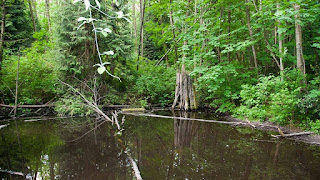CAMOSUN BOG ESSAY PR
Camosun Bog
It takes thousands of years for a bog to form. It starts off with a lake and peat starts to grow off the edges of the glacial moraine. Peat is also known as dead sphagnum. Dead sphagnum does not decay, which means the sphagnum grows upon the dead sphagnum. Bogs also form sphagnum moss.
The keystone species of a bog is sphagnum moss. A keystone species is what defines a bog. Sphagnum maintains the acidic conditions favoured by the bog plants. It has an unbelievable capacity to absorb water. It also pumps hydrogen ions into its environment, building a very acidic surrounding.
Peat is the definition of dead sphagnum. It is a mass of partially decayed vegetarian or organic matter. Peat (dead sphagnum) will always have its structural integrity. This means even after 4000 years the sphagnum will always remain in the bog and grow upon new sphagnum mosses. Peat does not turn into soil because after growing new sphagnum there would be layers of sphagnum.
Digging through a bog is like digging through time because it takes thousands of years for a bog to form. While digging through bog the layers of peat go down 2000 years worth of sphagnum moss. Each metre below the surface means about 400 years. Digging through a bog can lead to finding human bodies that were under peat as well as other artifacts.
There were many dissimilar artifacts that were found in the Camosun Bog. For example, glass marbles, button hats, an old hockey puck, and many different varieties of coins.
This old woman's observations she made was reminiscing about playing hockey at the Camosun Bog. She was put as a goalie because she could not skate as well as others at around age 8-9 years old with no skates. The trees around the bog were quite short, near 10 to 11 ft tall. The old woman picked huckleberries and created many memories and enjoyed her time at this bog.
Bogs are carbon sinks and in fact important due to removing CO2 from the airspace and storing its recalcitrant form of carbon where acidic and waterlogged conditions prevent decomposition. This also pulls out carbon dioxide from the atmosphere and goes through plants. Sphagnum mosses which are found in bogs. Carbon sinks position is to put a stop for carbon levels to rise.
Musqueam have been operating in the area of the Camosun bog for over 3,500 years. For different essential needs for example, medication, food, fishing, trapping, and gatherings.
Camosun Bog was destroyed because of dumping, native species and population pressure. The change in abiotic conditions caused "natives" to go into the bog are plants known as Labrador tea, western bog laurel, salal, lodgepole pine, sphagnum mosses, sundew and skunk cabbage.
WORK CITED

Comments
Post a Comment